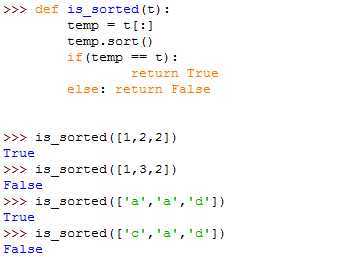标签:style blog http 2014 for io
The slice operator can take a third argument that determines the step size, so t[::2] creates a list that contains every other element from t. If the step size is negative, it goes through the list backward, so t[::-1] creates a list of all the elements in t in reverse order. Use this idiom to write a one-line version of is_palindrome

Write a function called is sorted that takes a list as a parameter and returns True if the list is sorted in ascending order and False otherwise. You can assume (as a precondition) that the elements of the list can be compared with the comparison operators <, >, etc.
For example, is sorted([1,2,2]) should return True and is sorted([’b’,’a’])
should return False

.
from Thinking in Python
标签:style blog http 2014 for io
原文地址:http://www.cnblogs.com/ryansunyu/p/3841586.html